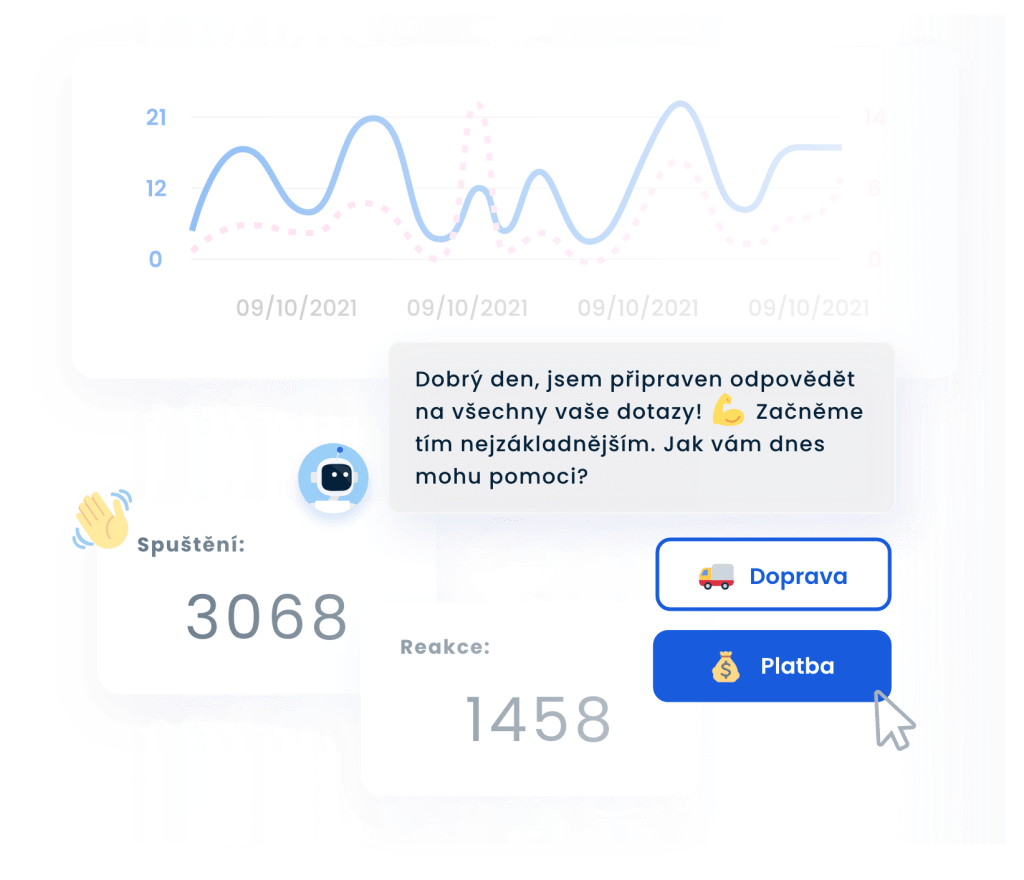Používejte live chat, je velmi efektivní
Komunikujte s návštěvníky webu, budujte vztahy. Poskytujte skvělý zákaznický servis a získávejte tak loajální a vracející se zákazníky.
Rychlé. Efektivní. A znovu rychlé.
Obsluhujte několik zákazníků souběžně
Staňte se součástí éry komunikace v reálném čase. Nahraďte e-maily a telefonní hovory live chatem, který vám umožní odbavovat několik konverzací v jeden moment. Zákazníci nebudou čekat a vy ušetříte čas.
Důvěřuje nám přes 100 000 zákazníků po celém světě
Předveďte svůj zákaznický servis v plné parádě
Rychlost znamená spokojenost
Používejte předchystané zprávy na klik. Zkratky vám umožní posílat konzistentní odpovědi velmi rychle. Budete se moci více soustředit na složitější potřeby zákazníků.
Budujte dlouhodobé vztahy
Prohlédněte si předchozí konverzace nebo historii nákupů zákazníka, abyste mu mohli odpovědět personalizovanou zprávou. Takové zprávy bývají zpravidla nejkonzervnější.
Několik kanálů pod jednou střechou
Ze Smartsupp můžete odpovídat zákazníkům na chatu i na Facebook Messengeru. Pokud už nejsou online, zpráva jim přijde e-mailem. Už nebudete muset přecházet sem a tam.
Hodnotná data na dosah kurzoru
Zjistěte, odkud vaši zákazníci přišli a co hledají. S integrovaným infopanelem a jejich historií procházení jste vždy o krok před konkurencí.
Užitečný tip
Neztrácejte potenciální zákazníky
Zapněte si kontaktní formulář. Když budete online, bude za vás sbírat e-maily od zákazníků, kteří vás potřebují, a budete se jim moci ozvat později. Číst více
Automatizovaní chatboti vám pomohou
Dejte si pauzu, zapojte chatbota
Filtrujte časté dotazy, abyste šetřili svůj drahocenný čas. Automatizujte, co jde, a zaměřte se na na individuální, komplexnější případy zákazníků, kteří vás opravdu potřebují.
Zjistěte o chatbotech vícPosilte své podnikání s naším konverzačním AI chatbotem!
Poznejte budoucnost konverzačního e-commerce z první ruky.
Nástroj, který zná potřeby týmů
Optimalizujte týmovou zátěž
Pracujte společně s ostatními členy týmu, když potřebujete pomocnou ruku, nebo konverzaci předejte expertovi na danou situaci.
Získejte hodnotnou zpětnou vazbu
Monitorujte hodnocení spokojenosti, abyste mohli udržovat vysokou kvalitu podpory. Podívejte se, jak celý tým pracuje, a vylaďte ho k dokonalosti.
Měřte efektivitu svého týmu
Zjistěte, kolik konverzací váš tým vyřeší, kolik času tráví online a jak dlouho průměrně odpovídá. Získáte lepší přehled a lépe tým pochopíte.
Spolehněte se na nás
Když nevíte kudy kam, pomůžeme vám
Svému nástroji rozumíme, protože i my o své zákazníky pečujeme. Náš tým podpory používá Smartsupp, aby vám poskytl nejlepší zákaznickou zkušenost, když potřebujete pomoc.
Důkazem jsou čísla – naši zákazníci důvěřují výsledkům

- 50 % dotazů automaticky vyřeší chatbot
- 600 nových e-mailových kontaktů
- 1,1 mil Kč hodnota nových objednávek
Jednou z výhod Smartsupp chatu je pro nás to, že je při prohlížení e-shopu vždy vidět na první pohled. Zákazník tak ví, že jsme tu pro něj 24/7, a že může napsat zkrátka kdykoliv.

Jan KučeraE-commerce manažer ASKO - NÁBYTEK

- 9,7% navýšení prodejů
- 10,3 % konverzní poměr pouze z chatu
- 2,3x vyšší průměrná hodnota objednávky
„Smartsupp vnímáme jako prodejní kanál, díky kterému jsme schopní výrazně navýšit naše celkové tržby. Konverzní poměr pouze z chatu je 10,3 %, což dokazuje výkonnost této služby.“

Martin KubicaVedoucí zákaznické podpory inSPORTline.sk

- +397% konverzní poměr
- 150 měsíční interakce chatbotů
- 95% hodnocení spokojenosti
"Komunikace je klíčová - díky používání live chatu zvyšujeme náš konverzní poměr. U návštěvníků, kteří s námi komunikovali na chatu, je prodej o 379 % vyšší oproti těm, kteří chat nepoužili."

Jan HoudekVýkonný ředitel a majitel společnosti Dokonalá Káva

- 60 % komunikace probíhá přes chat
- ½ pracovního dne ušetřená díky chatbotovi
- 30 % dotazů vyřešil chatbot
"Smartsupp Chatbot nám pomáhá ušetřit ½ pracovního dne a vyřeší 30 % dotazů našich zákazníků."

Šárka KaiserováŘeditelka provozu, práva & procesů

- 20 % komunikace probíhá přes chat
- 30 členný tým
- 9h denně online na chatu
"Smartsupp Chatbot běží na našich webových stránkách 24 hodin denně, 7 dní v týdnu a šetří spoustu času naši zákaznické podpoře."

Tomáš LinhartProjektový manažer

- 150 konverzací za den
- 3000 návštěv denně
- 40 % všech dotazů vyřeší chatbot
"Během hlavní sezóny máme až 150 konverzací denně. Díky chatu máme dostatek času na připravení kompletní odpovědi se se všemi informacemi. Nevzniká zde žádný tlak na odpověď jako u telefonního hovoru."

Irena ŽirovnickáManažer zákaznické podpory
Jednoduché spuštění na jakémkoliv webu
S našimi pluginy pro nejpoužívanější e-commerce platformy rozjedete Smartsupp do dvou minut. A v ostatních případech do čtyř.
Vyzkoušejte si to
Prochatujte si cestu ke spokojeným zákazníkům





















































